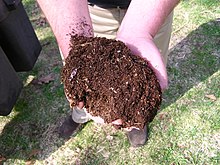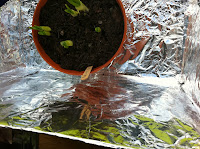Unlike previous classes, this week we stayed inside and did some indoor planting. For this we needed to find those long lost creativity skills to make our light boxes and biodegradable pots.
To make the light boxes we took a cardboard box and cut out the back panel. We drew diagonal down the sides of the box, creating two triangles. We cut along this line to create the sides of the light box. Next we covered the boxes in tin foil. This will reflect the light from the sun and in the room, helping the plants to grow. The growth of plants towards light is called Phototropism. We put the Paper White Bulbs that we planted last week into the light boxes along with the onion sets. These plants have grown a lot already since we planted them last week. We put the boxes and plants into the science lab, in front of the window so that they would get the most light, and are watering them every second day. To do this, we half fill the pot trays with water and sit the pots into them. The water is then absorbed by the soil and the roots of the bulbs in the pots.
We also made biodegradable pots out of newspaper. We moulded strips of newspaper around the end of a bottle and folded the ends down, securing them with masking tape. They are now ready to be filled with compost. The newspaper decomposes naturally in the ground, unlike plastic which releases toxic chemicals into the soil, so they are a more environmentally friendly alternative when planting.
This week we also learnt about composting, recycling and other types of waste disposal.
Composting
Compost is organic matter/waste that has been naturally decomposed and is used as fertiliser or a soil amendment. It has a high level of humus, which contributes to the soil's texture, moisture and nutrient retention.Most foods, e.g raw meat, vegetables, fruit, bread, etc., as well as teabags, newspaper and garden clippings can all be composted at home in the brown bin.
There are three types of composting: Home Composting, Vermicomposting and heat-based composting.


Home Composting is our everyday composting. It is the breakdown of food scraps, garden trimmings, wood ashes and other household organic waste by naturally occurring micro organisms.
Vermicomposting is similar to home composting however the natural degradation process is helped by the digestive processes of earthworms. It is typically done in a covered container with a bedding of dirt, newspaper or leaves and food scraps. It occupies less space than other methods so is ideal for high-density urban areas. Worms are a composter's best friend. The Elsenia Fetida earthworm, also known as the Red Wiggler, can eat it's weight in organic matter. They produce a rich brown matter that is an excellent natural plant food. For this reason, the Red Wigglers are used in vermicomposting.

Heat-based Compost is where high temperatures are used as a variable in the breaking down of compost to destroy weed seeds and pathogens. Different amounts of heat, water, air and food make different quality composts. Compost produce using all three methods creates a crumbly, earth smelling soil-like compost.
So How Does it Work?
Compost is composed of browns, e.g leaves, straw and woody waste, (carbon sources) and greens, e.g grass, food scraps (nitrogen sources). Decomposition of these browns and greens is caused by the activities and appetites of bacteria, fungi, invertebrates and micro organisms such as sowbugs, earthworms and slugs.
Benefits of Composting
- Composting is recycling natural organic materials, turning them into useful resources.
- Because of their high moisture content, food scraps and garden clippings aren't suitable for combustion facilities or landfill. Organic waste releases methane, a greenhouse gas that destroys the ozone, when it is put in landfill. For this reason, we must ensure that such waste is disposed of properly, i.e. by composting.
- Compost can be used as a soil additive for gardens and farms instead of fertilisers.
- Composting reduces the community's waste transportation and disposal costs.
Challenges to Composting
- Quality compost requires the right mix of moisture, particle size and temperature. Too dry and the decomposition is slowed down, too wet and odour problems arise.
- Excess food scraps, meat scraps, fats and oils in compost heaps can attract pests.
- Using compost before it is ready can kill the plant life it is applied to and encourage weed growth.
Trends in Composting
- Businesses involved in the food industry such as restaurants and grocery stores, create a lot of organic waste. Such businesses are beginning to compost their organic waste and in doing so are not only producing compost for resale but are also reducing their waste disposal costs.
- Compost is being used to 'clean up' land contaminated by hazardous waste, help reforestation and restore wetlands and natural habitats.
Composting in Action!
Here are some great sites to visit for more information on composting and how to get started, at home or in school
- Cornell University: http://compost.css.cornell.edu/index.html
- US Environmental Protection Agency (EPA): www.epa.gov
- EPA Solid Waste / Composting: www.epa.gov/compost
- US Composting Council: www.compostingcouncil.org
- Compost Ireland: www.cre.ie
- Clean Ireland Recycling: http://www.cleanireland.ie/composting
- Irish Peatland Conservation Council: http://www.ipcc.ie/advice/composting-diy/
- More Composting sites in Ireland: http://www.down2earthmaterials.ie/irish-composting-site-listings/




No comments:
Post a Comment